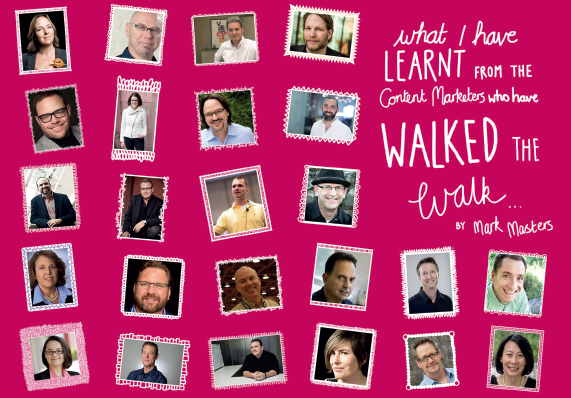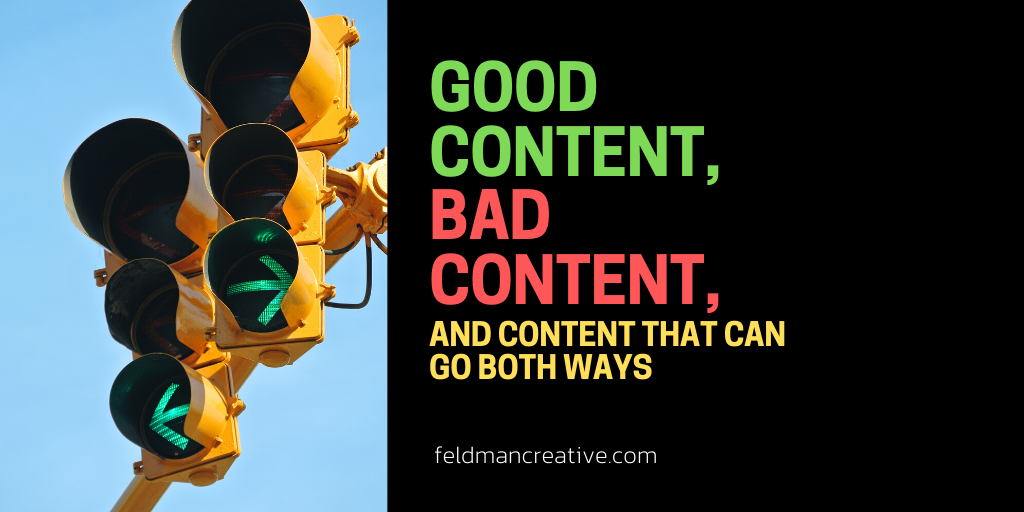Now here’s a chap who knows how to create content and repurpose it wisely. Meet Mark Masters of the ID Group in the U.K. His idea was quite simple: interview an extensive series of marketing leaders. I’m sure it took a ton of work, but he made it happen. I was thrilled to be included in a long list featuring Jay Baer, Joe Pullizzi, Ann Handley, Robert Rose, Doug Kessler, Marcus Sheridan, Lee Odden—and many more of my favorite authors, teachers, consultants, speakers—and probably yours too.
Mark took excerpts from his interview series, “Talking Content,” and created this roundup slide deck, “What I Have Learnt from Content Marketers Who Have Walked the Walk.”
Here’s the complete interview I did with Mark.
And stay tuned below for links to additional interviews I chosen to share because Mark got into “storytelling” with these guests too.
The Talking Content Marketing journey continues and we now stop alongside another content influencer, Barry Feldman.
Barry is the owner of Feldman Creative and specialises in helping companies plan and execute content marketing and inbound marketing programs to give their businesses a kick up the arse.
Six questions, six answers, let’s take a look at the art of storytelling.
Many businesses take a bland stance when it comes to content creation. Do businesses need to become more emotional to engage with their audience?
Duuuuude… rhetorical question if there ever was one. I often say, “You either get remembered or you get forgotten.” Your press releases, product pages, accolades, and even valuable how-to pieces all serve their purpose, but engaging me ain’t it. There’s only one way to get me to remember you, talk about you, and recommend your brand: make me feel something.
I dig into that topic, as it relates to blogging, in this post from my column (Content Marketing Minds) on Social Media Today: Content Marketing Minds: Why Insomniacs Love Your Blog.
Robert Rose mentions that the ‘stories we tell are the only differentiator we have left‘. Do all of us (and our businesses) have a story to tell?
I sure as hell hope so. It’s a great question—and challenge—because I think newcomers to the social space take that idea too literally. Telling a story can, but doesn’t have to, begin with “once upon a time” and conclude with “happily ever after.”
You simply need to introduce characters. You. Your employees. Your customers. Your friends. Your partners. Where there are characters there are conflicts, challenges, resolutions. That’s called a story and Robert’s right (he has a 99% right ratio), they serve to differentiate you—provided you give them a voice.
The recent Joe Pulizzi article on the ‘one thing media companies have that you need‘ and the editorial mission statement, how important is it to define what you stand for, rather than jumping in feet first and look to create content for everyone and everything?
I believe you’ve interpreted Joe’s take loosely. Sure, you need to define what you stand for, but that’s internal stuff. Few will care what you stand for unless you couch it in the reader’s terms. In Joe’s quest to get content marketers to create mission statements the way media companies do, he’s actually saying: (1) document why you create the content and (2) who it’s for. In the process, you’ll answer the vital question, who IT’S NOT for.
Robert, Joe and I have been ping-ponging this discussion ever since I first heard Joe rant on that. Naturally, I tossed in my two cents in a post, “Are You On a Mission to Fail.” I’m getting the sense you’ve followed this dialogue.
Is the role for businesses to become better teachers rather than relentless sellers, an important change of mindset to have (based on your ‘5 tips for creating content that’s educational‘)?
Well, businesses have a lot of roles, but as it relates to content marketing, yes. I think it’s Jeffrey Gitomer who writes, “People hate to be sold to, but love to buy.” Content marketers help them buy.
“Teach, don’t preach” is the idiom, I guess. Jay Baer’s spin is “help, not hype.” Ann Handley and C.C. Chapman offer a “Content Rule” this way: “share or solve problems, don’t shill.”
Everyone’s on the same page here. And yeah, if you dig into the qualities of a good teacher, you’ll find they carry over in a big way to content marketing. You mentioned the post where I wrote about teaching skills for CMI. Those ideas came from asking my daughters to tell me what makes their favorite teachers great. Valuable lessons.
I’m prone to saying “not really” to that question. Stories need not polarize readers. But opinions do.
As a writer, if and when you take a strong stance, the result will be some people are with you and some are not, you’ve done yourself a great favor. You can’t appeal to everyone and if you try, you’ll fail.
Erika Napoletano explains that best by saying when you travel down the middle of the road you become road kill.
With “Rock and Roll Content,” which is a live presentation, post, slideshow and soon, a podcast, I try to introduce a slightly different idea about branding and challenging content marketers to try new things. What I do is present 11 legends of rock, explain the signature styles that made them legends, and say to the audience… Try some of the ideas that feel right for your brand.
The “challenge status quo” suggestion comes from the Rolling Stones “chapter” because I feel they’re rock and roll’s classic contrarians.
Your work and point of view is well documented i.e. Convince & Convert, Copyblogger, CMI. What is your top tip for content being accepted and published from other credible channels?
Yeah, I get around. But shwew, large question, the fine art of guest posting. I’m compelled to knock out a quick list:
- Make connections
- Promote the sites (you want to contribute to) and its authors
- Look for blogs that are looking for guests
- Consume the content until you understand exactly what their editorial mission is
- Create killer content they’d be crazy not to publish
- Learn to accept rejection and keep trying
Blogging, and social media in general, is a reciprocal community. If you sincerely aim to help publishers, they’ll return the favor.
Read more interviews from Mark’s series, featuring Qs & As regarding storytelling:






